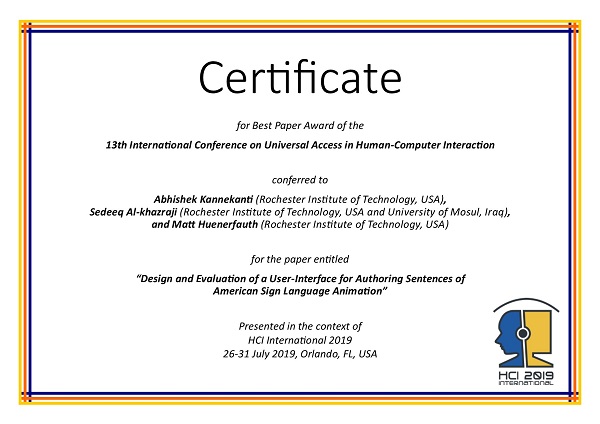
Best Paper Award for the 13th International Conference on Universal Access in Human-Computer Interaction, in the context of HCI International 2019, 16-31 July 2019, Orlando, FL, USA

Certificate for Best Paper Award of the 13th International Conference on Universal Access in Human-Computer Interaction
conferred to
Abhishek Kannekanti (Rochester Institute of Technology, USA),
Sedeeq Al-khazraji (Rochester Institute of Technology, USA and University of Mosul, Iraq),
and Matt Huenerfauth (Rochester Institute of Technology, USA)
for the paper entitled
"Design and Evaluation of a User-Interface for Authoring Sentences of American Sign Language Animation"
Presented in the context of
HCI International 2019
16-31 July 2019, Orlando, FL, USA
Paper Abstract
"Many individuals who are Deaf or Hard of Hearing (DHH) in the U.S. have lower English language literacy levels than their hearing peers, which creates a barrier to access web content for these users. In the present study we determine a usable interface experience for authoring sentences (or multi-sentence messages) in ASL (American Sign Language) using the EMBR (Embodied Agents Behavior Realizer) animation platform. Three rounds of iterative designs were produced through participatory design techniques and usability testing, to refine the design, based on feedback from 8 participants familiar with creating ASL animations. Later, a usability testing session was conducted with four participants on the final iteration of the designs. We found that participants expressed a preference for a “timeline” layout for arranging words to create a sentence, with a dual view of the word-level and the sub-word “pose” level. This paper presents the details of the design stages of the new GUI, the results, and directions for future work."
The full paper is available through SpringerLink, provided that you have proper access rights.